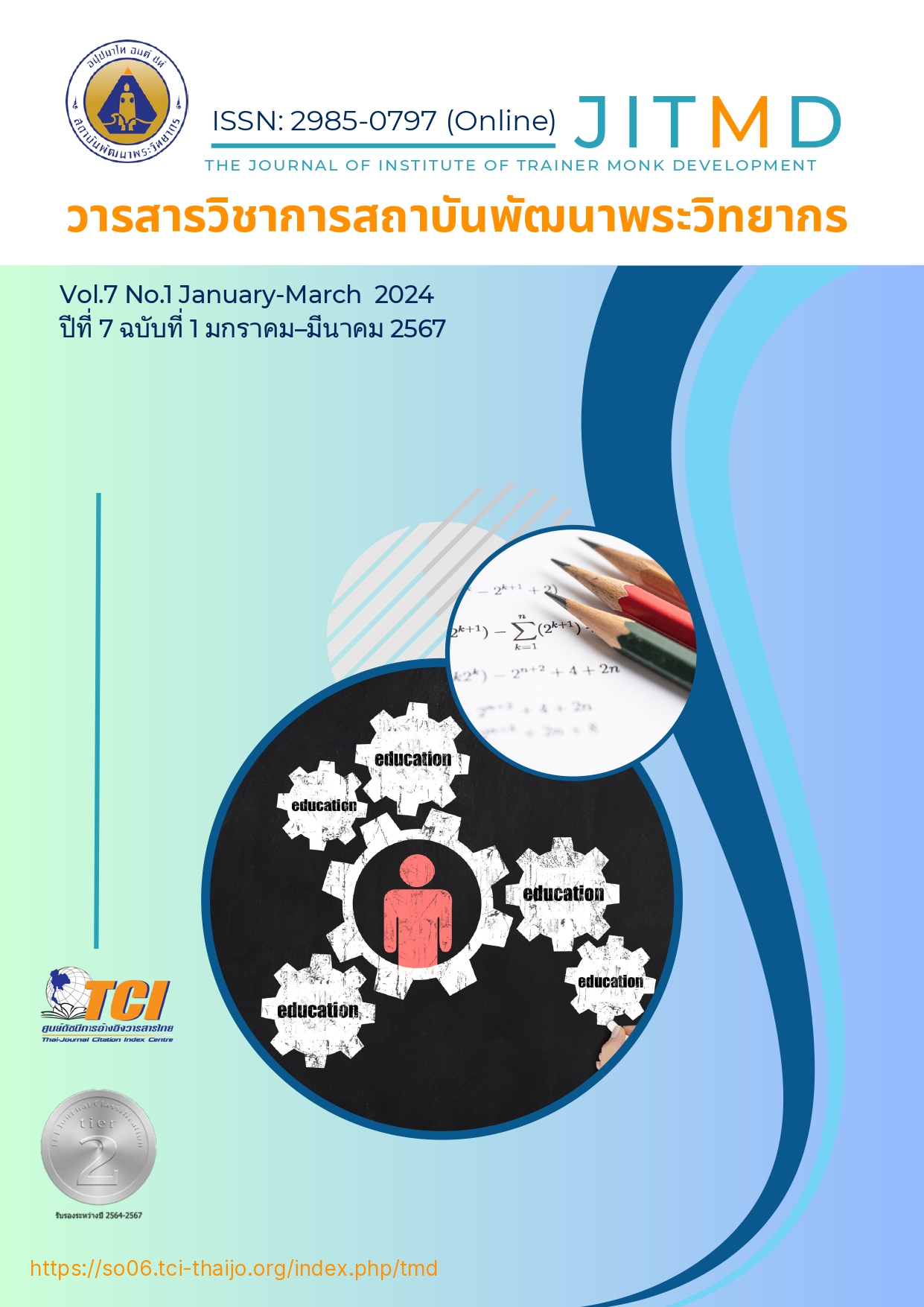Analyzing the Concept of Buddhist Peace in the Way of Life
Main Article Content
Abstract
This article has objectives are 1) To study the concept of Buddhism’s peaceful way of life. 2) To study the principles of Buddhism related to Buddhism’s peaceful way of life. 3) To integrate the concept of Buddhist peace in the way of life according to Buddhist principles, and 4) to present guidelines and generate a new knowledge about “Buddhist Peacefulness in the Way of Life” by studying documents and research. The findings found that “Peaceful means are methods that do not use any form of violence is classified into 3 types: Peaceful methods of fighting and demanding, Peaceful methods for resolving conflicts and peaceful ways of living life. For peaceful ways of living are divided into 4 methods: 1) Buddhist peaceful methods in the physical way of life, which is the persistence used of peaceful methods in the lives of individuals, including: middle way, the way of consumption, Supportive living factors, the way to be self-sufficient and secluded way of managing life and the way of restraint in organism 2) Buddhist means in the way of living life in terms of society and environment which is a peaceful way of human life with Society and environment with a peaceful culture 3) Buddhist peacefulness in the mental method which is peace of mind in characteristics of peace in mind and from defilements and 4) Peaceful way in the wisdom which is a process in Buddhist studies of peaceful methods according to the Threefold Principles, Making the way of daily life and be liable for applying peaceful methods, and all 4 peaceful methods mentioned above are all peaceful ways of life.
Article Details

This work is licensed under a Creative Commons Attribution-NonCommercial-NoDerivatives 4.0 International License.
บทความที่ได้รับการตีพิมพ์เป็นลิขสิทธิ์ของวารสารวิชาการสถาบันพัฒนาพระวิทยากร
ข้อความที่ปรากฎอยู่ในบทความที่ได้รับการตีพิมพ์ในวารสาร ถือเป็นความรับผิดชอบของผู้เขียนบทความ และข้อคิดเห็นนั้นไม่ถือว่าเป็นทัศนะและความรับผิดชอบของกองบรรณาธิการวารสารวิชาการสถาบันพัฒนาพระวิทยากร
References
มหาจุฬาลงกรณราชวิทยาลัย. (2539). พระไตรปิฎกภาษาไทย. ฉบับมหาจุฬาลงกรณราชวิทยาลัย.กรุงเทพมหานคร: โรงพิมพ์มหาจุฬาลงกรณราชวิทยาลัย.
กวีวงศ์. (2550). สารนิพนธ์พุทธทาสว่าด้วยสมานฉันท์และสันติวิธี. กรุงเทพมหานคร: สุขภาพใจ.
เขมานันท์ เขมานันโท. (2553). สันติภาพ ทางเลือกเดียวและศีล 5 (ปัญจศีล). พุทธวิธีสู่โลกสันติ. กรุงเทพมหานคร: ภูมิทอง.
ชัยวัฒน์ สถาอานันท์. (2534). สันติทฤษฎี-วิถีวัฒนธรรม (Peace theory and cultural elements). กรุงเทพมหานคร: มูลนิธิโกมลคีมทอง.
บัญชา เฉลิมชัยกิจ. (2544). ข้อธรรมคำคมพุทธทาสภิกขุ. กรุงเทพมหานคร: สุขภาพใจ.
ปรีชา ศรีวาลัย. (2546). สงครามโลกครั้งที่ 2. (พิมพ์ครั้งที่ 2). กรุงเทพมหานคร: โอเดียนสโตร์.
พระธรรมปิฎก (ป.อ. ปยุตโต). (2544). พุทธธรรม (ฉบับเดิม). กรุงเทพมหานคร: ดวงแก้ว.
พระพรหมคุณาภรณ์ (ป.อ. ปยุตโต). (2550). ความจริงและเมตตาที่กอรปด้วยปัญญา สลายความขัดแย้ง. กรุงเทพมหานคร: บริษัทพิมพ์สวย จำกัด.
พระพรหมคุณาภรณ์ (ป.อ. ปยุตโต). (2551). พจนานุกรมพุทธศาสตร์ ฉบับประมวลศัพท์. (พิมพ์ครั้งที่ 11). กรุงเทพมหานคร: เอส.อาร์.พริ้นติ้งแมสโปรดักส์ จำกัด.
พระไพศาล วิสาโล. (2553). สติ มรรคาแห่งสันติ. กรุงเทพมหานคร: เนชั่นบุ๊คส์.
พระไพศาล วิสาโล. (2544). สันติวิธี วิถีแห่งอารยะ. กรุงเทพมหานคร: โกมลคีมทอง.
มารค ตามไท. (2543). การจัดการความขัดแย้งด้วยสันติวิธีในสันติวิธี: ยุทธศาสตร์ชาติเพื่อความมั่นคง. กรุงเทพมหานคร: สถาบันยุทธศาสตร์ สำนักงานสภาความมั่นคงแห่งชาติ.
ราชบัณฑิตยสถาน. (2546). พจนานุกรมฉบับราชบัณฑิตยสถาน พ.ศ. 2542. กรุงเทพมหานคร: นานมีบุ๊คส์พับลิเคชั่น.
รุ่งธรรม ศุจิธรรมรักษ์. (2533). สันติศึกษากับสันติภาพ. นนทบุรี: มหาวิทยาลัยสุโขทัยธรรมาธิราช.
วันชัย วัฒนศัพท์. (2547). ความขัดแย้ง: หลักการและเครื่องมือแก้ปัญหา. (พิมพ์ครั้งที่ 2). นนทบุรี: สถาบันพระปกเกล้า.
โคทม อารียา. (2546). การส่งเสริมสันติวิธี. เอกสาร 30 ปี 14 ตุลา จดหมายข่าวประชาชน. 10(3): 23-25.
พระมหาหรรษา ธมมหาโส. (2548). รูปแบบการจัดการความขัดแย้งโดยพุทธสันติวิธี: กรณีลุ่มน้ำแม่ตาช้าง จังหวัดเชียงใหม่. วิทยานิพนธ์พุทธศาสตรดุษฎีบัณฑิต. บัณฑิตวิทยาลัย: มหาวิทยาลัยมหาจุฬาลงกรณราชวิทยาลัย.
พระมหาหรรษา ธมฺมหาโส (นิธิบุณยากร) (2561). พุทธสันติวิธี: การบูรณาการหลักการและเครื่องมือขจัดความขัดแย้ง. (พิมพ์ครั้งที่ 2). กรุงเทพมหานคร: หจก.ประยูรสาส์นไทยการพิมพ์.
พระมหากฤษณะ ตรุโณ,ดร. (2551). พระพุทธศาสนากับการสร้างสันติภาพโลก. สืบค้นข้อมูลเมื่อวันที่ 1 ธันวาคม 2566, จาก https://www.mcu.ac.th/article/detail/14299


